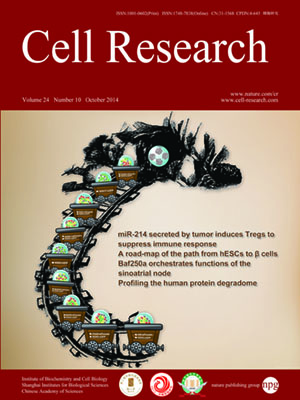
Volume 24, No 10, Oct 2014
ISSN: 1001-0602
EISSN: 1748-7838 2018
impact factor 17.848*
(Clarivate Analytics, 2019)
Volume 24 Issue 10, October 2014: 1181-1200
ORIGINAL ARTICLES
Systematically labeling developmental stage-specific genes for the study of pancreatic β-cell differentiation from human embryonic stem cells
Haisong Liu1,*, Huan Yang1,*, Dicong Zhu1,*, Xin Sui1, Juan Li2, Zhen Liang1, Lei Xu3, Zeyu Chen4, Anzhi Yao4, Long Zhang5, Xi Zhang5, Xing Yi4, Meng Liu1, Shiqing Xu6, Wenjian Zhang6, Hua Lin7, Lan Xie8, Jinning Lou6, Yong Zhang5, Jianzhong Xi2 and Hongkui Deng1,4,9
1Shenzhen Stem Cell Engineering Laboratory, Key Laboratory of Chemical Genomics, Peking University Shenzhen Graduate School, Shenzhen, Guangdong 518055, China
2Department of Biomedical Engineering, College of Engineering, Peking University, Beijing 100871, China
3Department of Hematopoietic Stem Cell Transplantation, 307 Hospital, Academy of Military Medicine Sciences, Beijing 100071, China
4The MOE Key Laboratory of Cell Proliferation and Differentiation, College of Life Sciences, Peking-Tsinghua Center for Life Sciences, Peking University, Beijing 100871, China
5BGI-Shenzhen, Shenzhen, Guangdong 518083, China
6Institute of Clinical Medical Sciences, China-Japan Friendship Hospital, Beijing 100029, China
7Department of Gynecology and Obstetrics, China-Japan Friendship Hospital, Beijing 100029, China
8Department of Gynecology and Obstetrics, Beijing Renhe Hospital, Beijing 102600, China
9Peking University Stem Cell Research Center, Department of Cell Biology, School of Basic Medical Sciences, Peking University Health Science Center, Beijing 100191, China
Correspondence: Hongkui Deng, E-mail: hongkui_deng@pku.edu.cn; Jianzhong Xi,(xi@coe.pku.edu.cn)
The applications of human pluripotent stem cell (hPSC)-derived cells in regenerative medicine has encountered a long-standing challenge: how can we efficiently obtain mature cell types from hPSCs? Attempts to address this problem are hindered by the complexity of controlling cell fate commitment and the lack of sufficient developmental knowledge for guiding hPSC differentiation. Here, we developed a systematic strategy to study hPSC differentiation by labeling sequential developmental genes to encompass the major developmental stages, using the directed differentiation of pancreatic β cells from hPSCs as a model. We therefore generated a large panel of pancreas-specific mono- and dual-reporter cell lines. With this unique platform, we visualized the kinetics of the entire differentiation process in real time for the first time by monitoring the expression dynamics of the reporter genes, identified desired cell populations at each differentiation stage and demonstrated the ability to isolate these cell populations for further characterization. We further revealed the expression profiles of isolated NGN3-eGFP+ cells by RNA sequencing and identified sushi domain-containing 2 (SUSD2) as a novel surface protein that enriches for pancreatic endocrine progenitors and early endocrine cells both in human embryonic stem cells (hESC)-derived pancreatic cells and in the developing human pancreas. Moreover, we captured a series of cell fate transition events in real time, identified multiple cell subpopulations and unveiled their distinct gene expression profiles, among heterogeneous progenitors for the first time using our dual reporter hESC lines. The exploration of this platform and our new findings will pave the way to obtain mature β cells in vitro.
10.1038/cr.2014.118
FULL TEXT | PDF
Browse 2597


